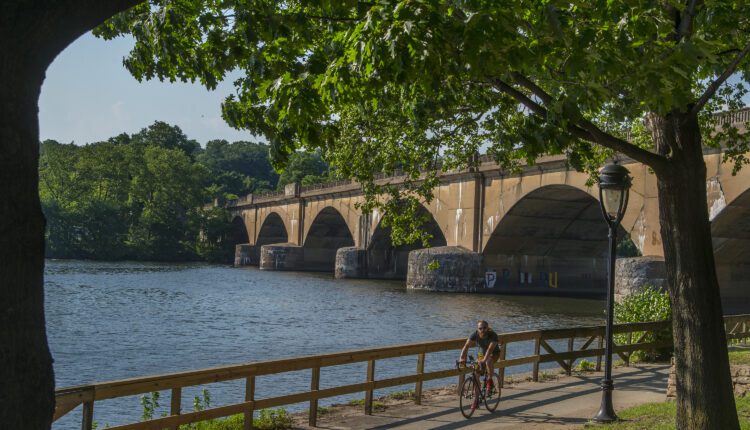
Photo by R. Kennedy, courtesy of Visit Philadelphia.
Hikers and bikers can follow the Schuylkill River Trail through centuries of history and development in southeastern Pennsylvania.
As the Schuylkill River winds through southeastern Pennsylvania, it helps to tell the story of the nation’s founding as well as the rise and fall of industry. And though the Schuylkill may be hard to pronounce, thanks to the Schuylkill River Trail, the river and its rich history are easy for those on foot or wheels to access.
The trail is built mostly along abandoned rail lines, and while currently only partially complete, when finished, it will stretch 120 miles from the confluence of the Schuylkill and the Delaware Rivers in Philadelphia to the old mining town of Frackville in Schuylkill County. Today, more than 75 miles of the trail is open for exploration, passing through Philadelphia, Montgomery, Chester, Berks, and Schuylkill Counties.
Because the trail is mostly flat and either paved or made of crushed stone, it’s well-loved and well-traveled by cyclists, hikers, families, and runners. Plus, because the trail passes through historical areas, you’ll find a bevy of historic sites you can visit along the trail. And that’s in addition to the gorgeous scenery of rural farmland, small towns, the big city, and, of course, the Schuylkill River itself.
We’ve put together a guide to the Schuylkill River Trail and how you can experience the history that the river has witnessed over hundreds of years. We’ll start in Philadelphia and travel the length of the current trail, though keep in mind that the trail isn’t complete, and not all sections currently connect. Ready to hit the trail?

Photo by R. Kennedy, courtesy of Visit Philadelphia.
Philadelphia
More than 30 miles of the Schuylkill River Trail are within the borders of Philadelphia itself.
Bartram’s Garden
The site of the oldest botanic garden in the country will start our trek through history on the Schuylkill River Trail. Sitting on the banks of the Schuylkill, Bartram’s Garden was founded by the botanist John Bartram in 1728. The nearly 300-year-old garden is now a public recreational area and a historic landmark. Check out the community farm, the historic buildings that include what’s likely the oldest barn in Philadelphia, and, of course, the gardens.
Old City Philadelphia
Because Philly is such a historic city—it’s where the U.S. was born, after all—we would be remiss to mention Philadelphia’s Old City. The history-loving trail traveler might want to wander the colonial sites of Old Town like the Betsy Ross House, Elfreth’s Alley, and, of course, Independence Hall.
Boathouse Row
The boathouses along the Schuylkill River that make up Philly’s Boathouse Row have a history that goes back to the 1850s when the first boating clubs were built on the river. Today, the clubs provide a beautiful sight—especially when lit up in the evening—as well as a necessary stop for fans of rowing.
Wissahickon Valley Park
The area that is now Wissahickon Valley Park was once the home of the Lenape (Delaware) people, followed by settlers like the religious leader Johannes Kelpius, who saw the Wissahickon as the perfect place to experience the end of the world. Then, it was a lodestone for industry, dotted with dozens of mills making paper, milling wheat, cutting lumber, and more.
Today, the Wissahickon Valley is the site of a large city park that serves as an urban oasis within Philadelphia. Forbidden Drive, a wide trail that runs through the park, was originally a turnpike through the park, built in the 1850s. You can access the Wissahickon Valley Park by way of the Schuylkill River Trail; the Lincoln Drive Trail connects the Schuylkill River Trail to Forbidden Drive.
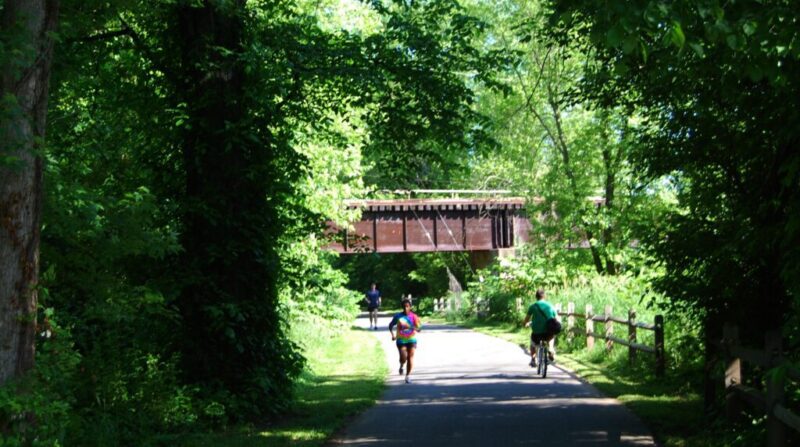
Photo courtesy of JR P/CC BY-NC 2.0.
Montgomery County & Chester County
The stretch of the trail in Montgomery County that links the Philadelphia border to Mont Clare is roughly 26 miles long. After you cross the river from Mont Clare, you’ll enter Chester County’s Phoenixville. The trail then heads to Parker Ford, but the section from Parker Ford to Pottstown is not yet complete.
Valley Forge National Historic Park
You’ll enter Valley Forge National Historic Park via the Betzwood Trailhead of the Schuylkill River Trail. This massive park has 3,500 acres of forests, meadows, and historic monuments commemorating the Revolutionary War. It’s at Valley Forge, after all, that the scrappy Continental Army under General George Washington camped for the winter of 1777 through the spring of 1778. The wet chill was miserable, but the conditions kept the British from ambushing them. Still, roughly 2,000 soldiers died at Valley Forge simply from disease.
You can explore the park by touring the encampment by bike or trolley—and you can rent a bike if you don’t have your own. See reconstructions of the army’s log cabins, statues of historical figures, and even the house where Washington stayed at Valley Forge.
Schuylkill Canal
You can see some of the ruins of the Schuylkill Canal as you traverse the Schuylkill River Trail. The canal served as an important waterway throughout the 19th and early 20th centuries, and while it’s no longer in use for commercial transportation, one of the last watered sections of the canal can be found between the Port Providence Trailhead and Mont Clare. And just north of the trail, you can see the last lock still in operation on the Schuylkill River.
Visit the Locktender’s House on the third Sunday of each month to learn more about the Schuylkill Canal and how it helped facilitate the industrial revolution in southeastern Pa. You can also see a lock demonstration on the third Sunday of the month.
Phoenixville
While Phoenixville may be known as a trail destination because of several excellent restaurants and breweries, the town is also home to some historic sites. The Colonial Theatre, for example, has been hosting shows since the early 1900s, and it’s also famed for playing a role in the classic 1958 horror movie “The Blob.” (The theater even hosts an annual “Blobfest” celebrating the movie.)
You can also visit historic sites like the Phoenixville Foundry, home to the Schuylkill River Heritage Center, where you can learn more about the river’s role in forging Pennsylvania’s legacy of iron and steel.
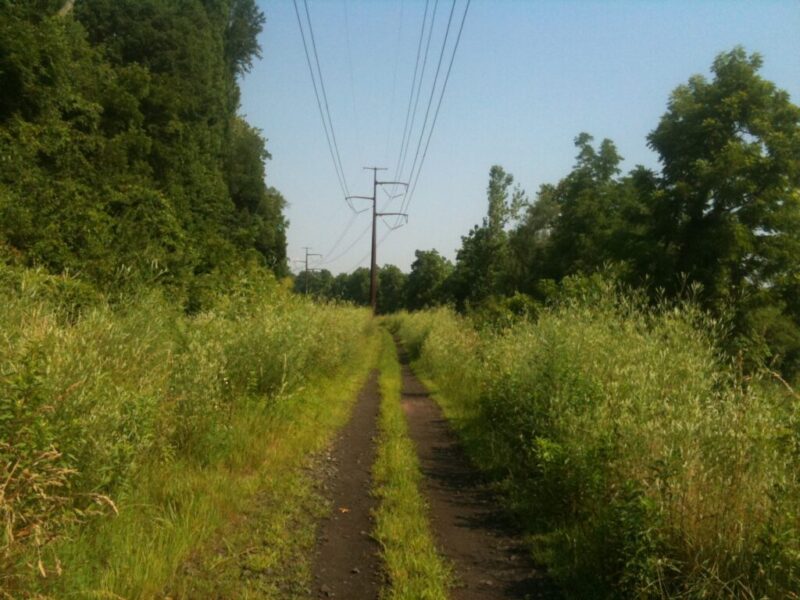
Photo courtesy of Susan and John Spencer/CC BY-NC 2.0.
Berks County & Schuylkill County
Picking up the trail in Pottstown, cyclists soon pass into Berks County. The trail runs 19 miles from Pottstown to Reading. From Reading to Hamburg, the trail can only be accessed on the road, but once you reach Hamburg, the Schuylkill River Trail continues for seven miles to Auburn.
Birdsboro
Though the 4.5-mile section of the Schuylkill River Trail that crosses through Birdsboro is an on-road section sharing the road with other vehicles, this part of the trail treats cyclists and walkers to scenic views of the river and surrounding hills from old railroad bridges. The rest of the Berks County section is similarly beautiful, traveling through wooded areas.
Keep in mind that some parts of this section of the trail are steep.
Allegheny Aqueduct Historical Park
After you hop off the on-road section of the trail at Gibraltar, you’ll soon find yourself near Allegheny Aqueduct Historical Park. The aqueduct is a large stone bridge built in 1824. Nearby, the Beidler House, built in 1783, sometimes hosts historical events related to the history of the aqueduct, the house, and the house’s mill, of which only ruins remain.
Hamburg to Auburn
Hamburg is a small town with a big Pennsylvania Dutch influence, and you can explore the area to learn about its agricultural and industrial past—and eat some quality Pa. Dutch food. Following a jaunt in the small town, the remaining 9-mile stretch of the Schuylkill River Trail between Hamburg and Auburn is rural and lovely. You’ll travel alongside Blue Mountain until you reach a historic, scenic railroad bridge. Eventually, the trail extends all the way to Frackville!
This article first appeared on Good Info News Wire and is republished here under a Creative Commons license.
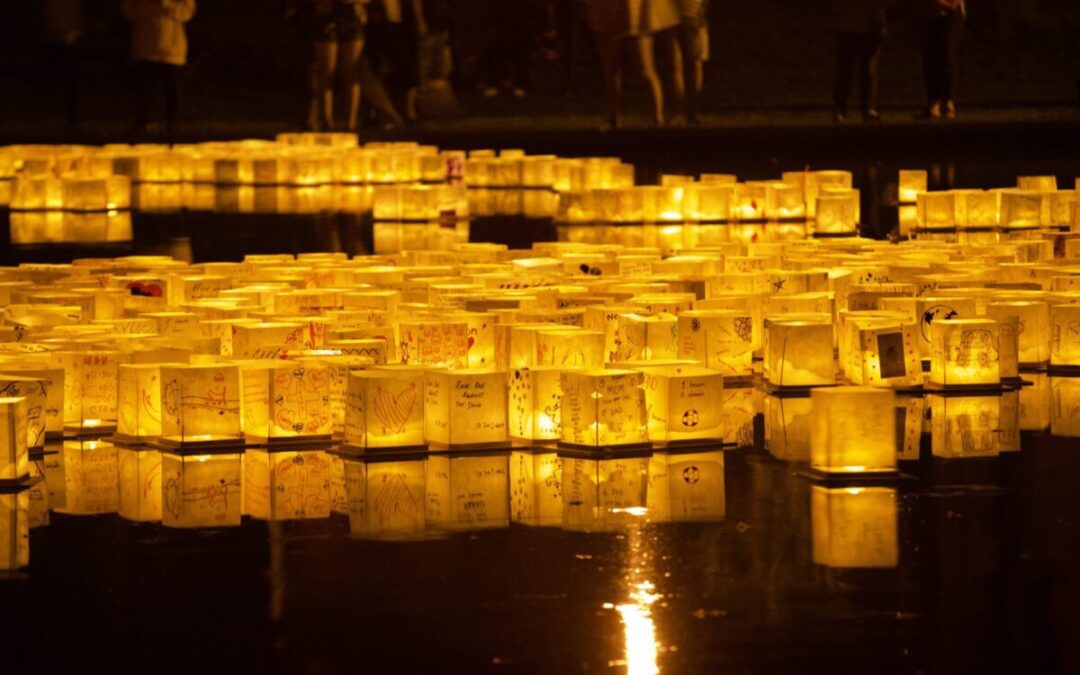
10 events in Pittsburgh to take your kids to before summer ends
Make the most of the rest of summer at these 10 festivals and events in Pittsburgh. While the school days will soon be upon us, we still have a...
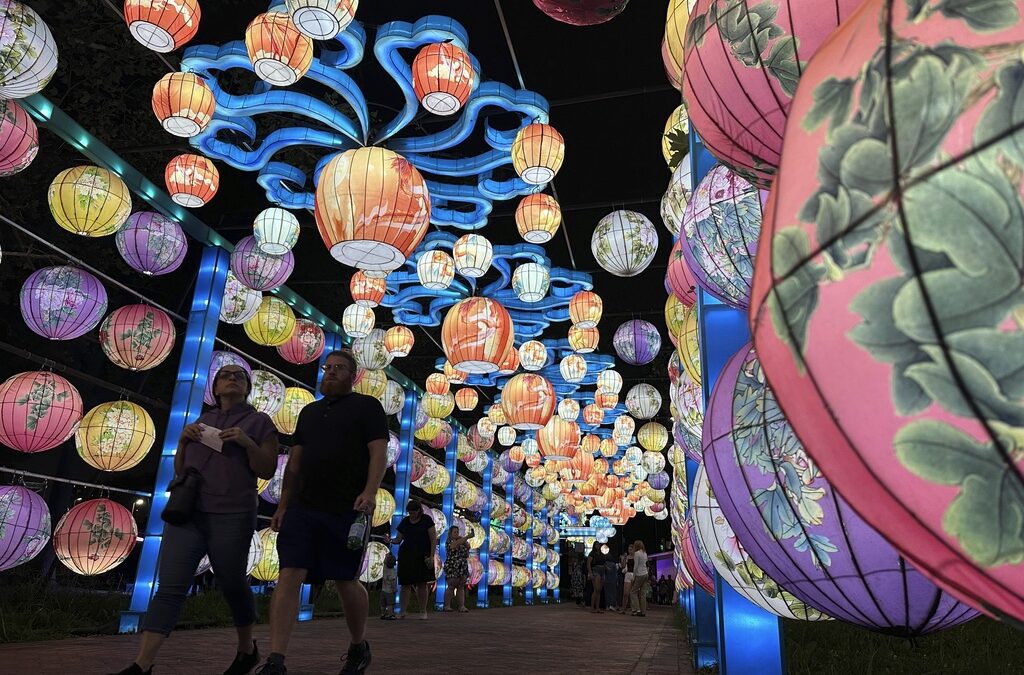
The annual Chinese Lantern Festival in Philadelphia is a symbol of summer in the city
What began as a novel summer event in 2016 has blossomed into a cherished summer tradition for Philadelphia. Now in its eighth year, the...

With the ban lifted, Pennsylvania hunters get 13 Sundays in 2025
Pennsylvania hunters will have 13 straight Sundays to go out in the woods and fields this fall. The Pennsylvania Game Commission met on Monday to...
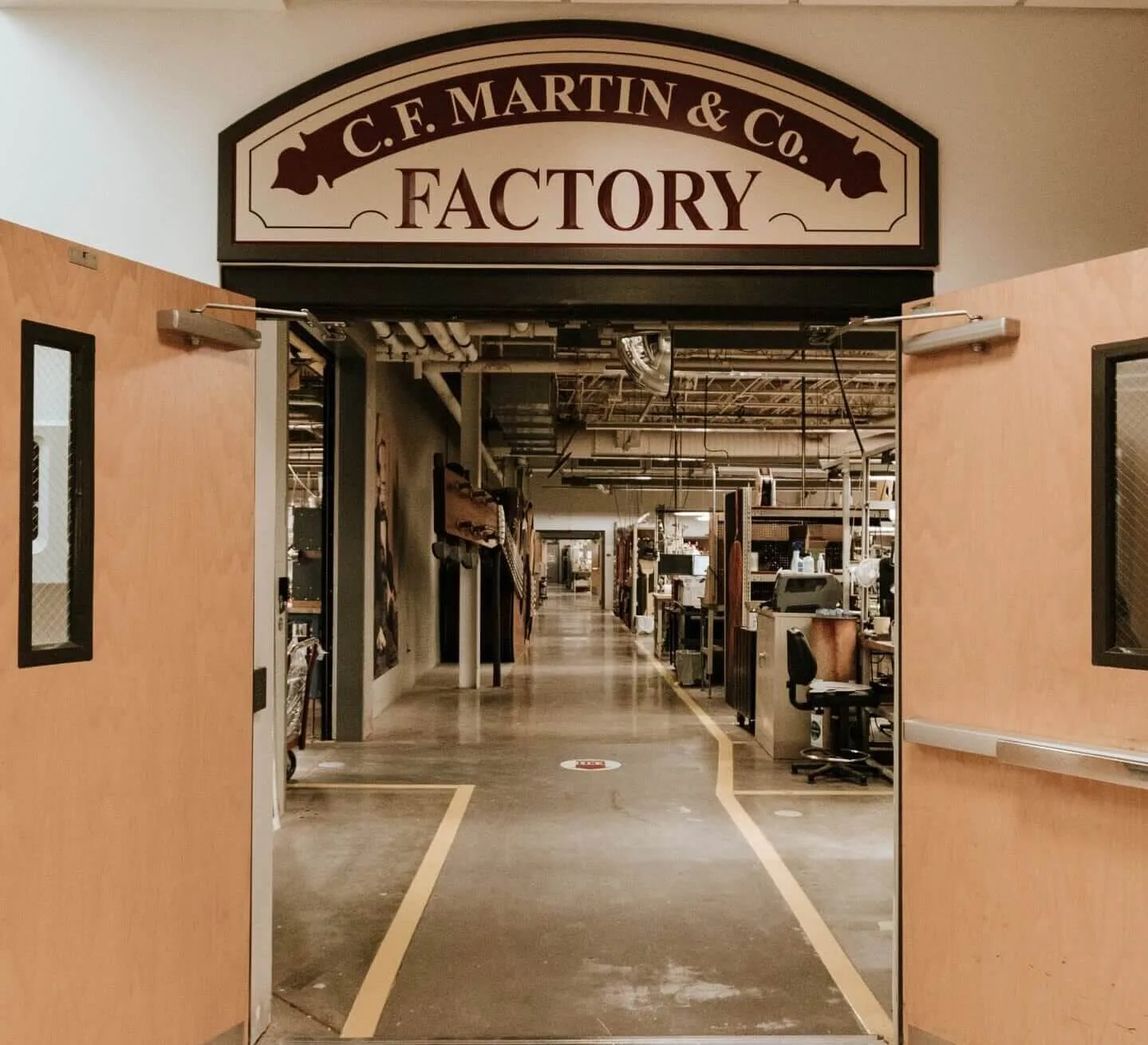
10 fun factory tours in Pennsylvania
Get a first-hand look at how guitars, coins, potato chips and more are made right here in Pennsylvania on these factory tours. From food and...
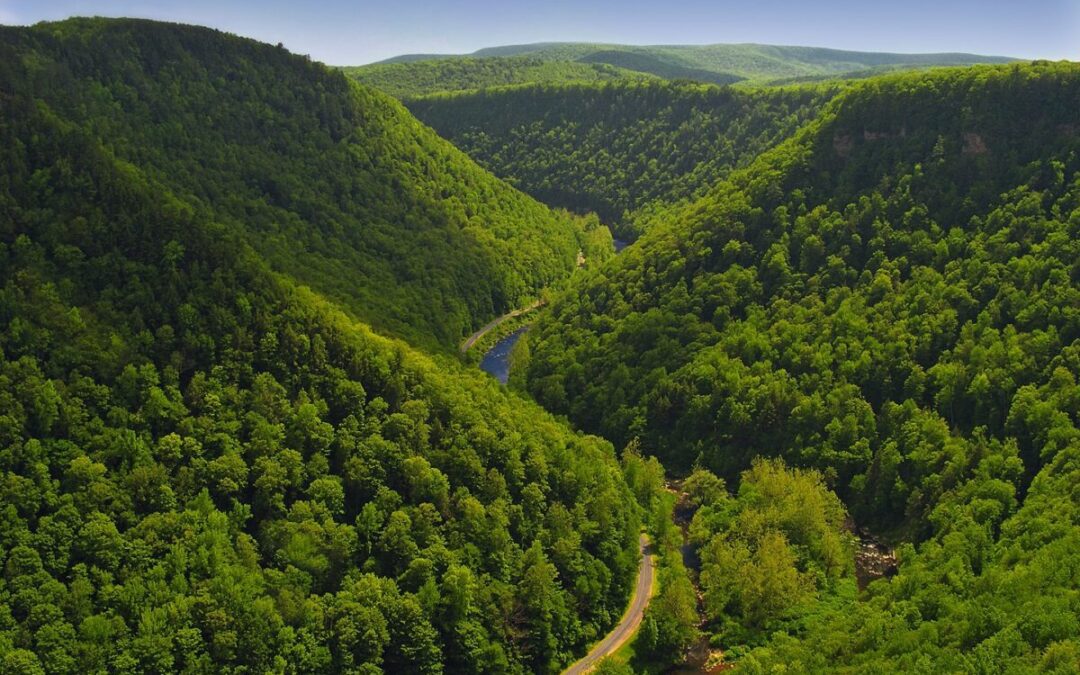
Remote attractions in Pennsylvania that are 100% worth the drive
If you’re looking for an escape that’s off the beaten track, these 10 unique attractions in Pennsylvania promise unforgettable experiences. This...





